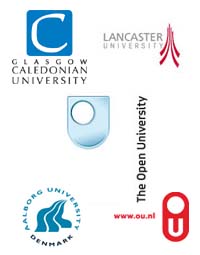

Reading screens: a critical visual analysis
Sian Bayne, Zoe Williamson, Jen Ross
University of Edinburgh, Edinburgh, United Kingdom
Abstract
This paper conducts a critical visual analysis of an online learning resource, exploring the potential of visual methodologies for reading and analysing the media through which pedagogy is constructed and expressed. Visual methods have tended to be rather neglected in research into online and networked learning (Bayne 2008), but a close reading of the screen interface can be a generative research method in this context – one which connects the ‘digital turn’ with the ‘visual turn’ in ways which are highly productive.
Methodologies for describing and critiquing the image – emerging from the fields of art history, cultural studies, anthropology, sociology, linguistics, psychoanalysis and media studies – include content analysis, iconography, semiotics, social semiotics and visual ethnography. The term ‘visual cultural studies’ perhaps most usefully, and loosely, encompasses this methodological diversity, with its focus both on the way in which ‘meaning and power are articulated within specific images’, and how ‘such images are produced and consumed within a wide range of social, economic and cultural contexts’ (Lister and Wells 2001: 63).
The paper will take a critical approach to considering the visuality of a collection of recently-created webquests developed by the UK National Museums. In discussing the visual semiotics of this particular interface, the paper will show how this contemporary online learning resource is structured around a linear logic dominated by a print-informed understanding of the way in which reading and learning works online (Kress and van Leeuwen 1996). A series of learning spaces which were intended to nurture the idea of learning from images, have in the end been designed in a way which systematically de-privileges the image, preventing sustained engagement with digital and visual modes and, we would argue, limiting the capacity for users critically to engage in a genuinely ‘networked’ learning.
The analysis will draw on a two-year research project into museum learning, conducted as part of the UK National Museums Online Learning Project, a £1.7m programme led by the Victoria and Albert Museum, aiming to improve levels of usage of the UK National Museums’ digital collections.[i]The research presented here will use the visual analysis as a way to draw critical connections between the constraints of the interface demonstrated in the webquests and the cultures of control and surveillance operating in school online learning more widely. Conclusions will be drawn relating to the usefulness of the methodological approach used, highlighting the applicability of these findings to areas of adult and higher education.
[i]The NMOLP web site is at: http://www.vam.ac.uk/about_va/online_learning/index.html
| About NLC | Welcome Messages| Acknowledgwments | Conference Proceedings| Keynote Speakers| Index of Presenting Authors| Contact |